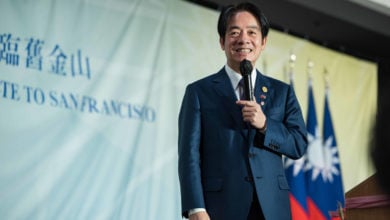Photo: Aircraft carriers on a U.S. military base in the South China Sea. Credit: U.S. Pacific Fleet (CC BY-NC 2.0)
In a speech delivered in May of 2022, Secretary of State Antony Blinken identified China as the “most serious long-term challenger to the international order” and announced the administration’s commitment to “shape the strategic environment around Beijing” in order to advance U.S. interests—all but spelling out Washington’s policy of containment toward the country. This policy, which took shape over the course of multiple administrations and reflects a consensus view within the U.S. ruling class, continues to intensify today and is a source of grave danger for everyone on the planet.
The “international order” Blinken spoke of describes the imperialist post-World War II global system that aims to force underdeveloped countries into accepting the unrestricted movement of capital under the guise of advancing “human rights” and “liberal democracy.” It stands to reason that China’s economic rise poses a threat to this U.S.-dominated unipolar international arrangement, and this fear of the U.S. losing its status as the dominant global power forms the basis of Washington’s foreign policy vis-a-vis Beijing. Presenting this competition as an existential one of “democracy” versus “authoritarianism,” the U.S. applies a strategy of containment toward China to blunt its rise: by seeking to isolate it through military encirclement, foreclosing its access to key markets, and cutting it off economically from the rest of the world. This policy is intended to cripple China’s development, ensuring Western capitalism’s control over the entire globe.
Origins of containment policy
China has long harbored justified fears of U.S. containment, since it was such a centerpiece of U.S. policy during the first Cold War that resulted in the collapse of the Soviet Union. In a March 7 speech, Xi Jinping went so far as to bluntly state, “Western countries led by the United States have implemented all-around containment, encirclement and suppression of China, which has brought unprecedented severe challenges to our country’s development.”
The strategy behind this containment policy was first outlined in historian and U.S. diplomat George F. Kennan’s 1946 “Long Telegram” sent to the State Department from the U.S. embassy in Moscow, which was later expanded and published as “The Sources of Soviet Conduct” in the July 1947 issue of Foreign Affairs. Kennan stated,
The main element of any United States policy toward the Soviet Union must be a long-term, patient but firm and vigilant containment of Russian expansive tendencies … Soviet pressure against the free institutions of the Western world is something that can be contained by the adroit and vigilant application of counterforce at a series of constantly shifting geographical and political points, corresponding to the shifts and manoeuvers of Soviet policy, but which cannot be charmed or talked out of existence.
In the eyes of Kennan and the U.S. government, the very existence of the Soviet Union’s socialist system was irreconcilable with the emerging global capitalist order led by Washington and thus needed to be “contained” to prevent its spread.
This desire to curtail Soviet influence led to the creation of NATO, the expansion of the CIA, wars in Korea and Vietnam and coups across Latin America and Africa to thwart the spread of communism. U.S. sanctions and embargoes were placed against the Soviet Union in an attempt to choke the economy.
This external pressure applied by the United States Kennan predicted, would then heighten the Soviet Union’s own internal contradictions, “promot[ing] tendencies which must eventually find their outlet in either the break-up or the gradual mellowing of Soviet power.”
The ultimate dissolution of the Soviet Union in 1991 upheld this strategy of containment as a success for those in Washington policy circles, and it would provide a blueprint for how to counter China’s rise in the 21st century.
Military encirclement
A major component of U.S. containment strategy toward China has been surrounding the country with a chain of military bases and hostile military alliances. With bases across South Korea, Japan, Guam, and Singapore, the U.S. has steadily been creating a military arc around China. While China only has eight overseas military bases, the U.S. has 313 military installations in East Asia alone.
Encirclement was first brought up during the George W. Bush administration, when then-National Security Advisor Condaleeza Rice recommended the formation of an anti-China alliance in Asia to shift the balance of power to the United States. Though this plan ended up sidetracked as the “war on terror” shifted focus and military resources toward the Middle East, the Obama administration returned to the containment strategy through its “pivot to Asia”: it increased military ties with Vietnam, the Philippines, and Australia; mediated diplomatic relations between Japan and South Korea; forged a deal with the Philippines to host U.S. military installations; restored diplomatic relations with Myanmar; increased naval presence in Singapore; and hosted a summit for the first time in 2016 with leaders from the Association of Southeast Asian Nations.
It was under the Trump administration, however, that this strategy of military encirclement was ramped up and pursued in earnest. Then-Secretary of State Mike Pompeo revived the security alliance between the U.S., Japan, India, and Australia known as the Quadrilateral Security Dialogue, or QUAD. Often referred to as the “Asian NATO,” the QUAD participates in military exercises together and strategizes to offset China’s influence in the “Indo-Pacific”. The Trump administration also forged closer diplomatic relations with Taiwan and stronger military ties with Australia, Japan, and South Korea, and increased U.S. military activity in the South China Sea.
And the Biden administration has only further escalated the encirclement strategy. It was this administration that created AUKUS — the military alliance between the United States, the United Kingdom, and Australia — and JAPHUS — a trilateral alliance between the U.S., Japan, and the Philippines — both of which are aimed at countering China. And in December 2021, Biden signed the 2022 National Defense Authorization Act, a $768 billion defense bill with a particular focus on China’s containment. Most of this funding will be used towards ships and planes to support U.S. military presence in the South China Sea and for programs to strengthen military ties in the Indo-Pacific. The bill also allocates $7.1 billion to “attempt to improve the current posture, capabilities, and activities of U.S. forces in the Indo-Pacific region.”
Further completing the military arc surrounding China stretching from South Korea and Japan in the north to Australia in the south, Secretary of Defense Lloyd Austin in February secured a deal with the Philippine government to grant U.S. access to four of its military bases, bringing the total number of U.S. installations in its former colony to nine. Three of these bases are situated in the north, near Taiwan. And on April 11, the United States and the Philippines hosted Balikatan, the annual joint war games exercises between the two countries. This year’s exercises were the largest yet, with 17,600 troops participating. All of this is in preparation for direct military confrontation, with the Philippines pulled in as the first line of defense should a war erupt over Taiwan.
U.S. officials and Congress have also pushed for full militarization of Taiwan, urging the administration to flood the island with weapons and employ a “porcupine strategy” of asymmetrical warfare to deter an invasion by China. This dangerous and reckless maneuver would effectively force Taiwan into an arms race.
The goal of this military encirclement, according to defense policy expert Michael T. Klare, is “to enable Washington to barricade [China’s] military inside its own territory and potentially cripple its economy in any future crisis,” leaving it with no other option but to “fight its way out of containment.”
The U.S. government, then, is actively pushing China into a direct military confrontation.
Belt and Road: China’s counter-containment strategy
The heavy U.S. presence and network of “defensive” alliances across the South China Sea and Indo-Pacific is not only intended to project military power, but it is also a way of tightening the economic noose around China. The military encirclement is itself a form of economic containment. The South China Sea is a geostrategic location with one third of global trade passing through it, accounting for $3.4 trillion in 2016. China is victim to what’s known as the “Malacca dilemma”: 60% of its trade and 80% of its oil imports flow through the South China Sea and in and out of the Malacca Strait, a key shipping lane located between Sumatra and Malaysia. With such a heavy naval presence surrounding the chokepoint, the U.S. or its military allies could potentially blockade access to the port, or any surrounding sea line of communication, bringing the Chinese economy to a standstill.
It was this militarization of the South China Sea and fears of containment that in large part drove China to develop its Belt and Road Initiative. BRI encompasses a network of high speed rails, highways, and alternative shipping routes which would allow China to import oil and transport goods to its trading partners, bypassing the maritime trade route encircled by U.S. military bases and naval ships.
BRI constitutes a counter-containment measure by not only circumventing military encirclement, but by also shifting the economic center of gravity toward China through better connecting it to the emerging economies of Africa and other parts of Asia, as well as Europe.
Tech containment
The U.S. tech war on China is a key front in the new Cold War and comprises another major component of this containment strategy. In its Made in China 2025 plan, the Communist Party of China determined technological innovation as central to its economic development. The strategy held that it was technological advances that would transform the country from a semi-peripheral manufacturing hub of cheap consumer goods to one of high-tech manufacturing and innovation in the global supply chain. Central to MIC 2025 is the goal of China developing its own domestic firms so that it no longer needs to depend on foreign technology imports.
As advances in chip technology could revolutionize breakthroughs in other areas, the semiconductor industry is considered pivotal to this industrial plan. Semiconductors are used in consumer electronics equipment like digital televisions, game consoles, computers, smartphones, wireless networks, and in military and aerospace equipment like drones, satellite systems, and radar equipment. China spends more each year on importing these chips than it does oil.
Recognizing China’s reliance on chip manufacturing, the Biden administration has made moves to block access in order to blunt the rise of its tech sector. In October of 2022, Biden introduced a sweeping ban on semiconductor exports to China, and then in January of this year, he reached an agreement with the Netherlands and Japan to restrict their exports of chip-making equipment to the country. With the U.S. cutting off access to this technology, China’s ability to produce cutting edge military applications and AI technologies has been severely set back.
The strategy of tech containment is not one unique to the current administration. Before Biden came into office, Trump imposed sanctions on Huawei and severely restricted the Chinese telecommunications company from the U.S. market. In 2019, Trump cut off Huawei’s access to Google music and other smartphone services, and then later followed that up with new sanctions which prohibited the use of American technology to produce components for its products. And then Trump further tightened these restrictions the following year, with a new round of sanctions which blocked Huawei from accessing chips produced with tools acquired from the United States. Since taking office, Biden has moved toward a total ban of the Chinese company, signing into legislation prohibiting it from receiving new equipment licenses from U.S. regulators. The administration has also convinced its allies to follow suit: South Korea, Japan, Germany, the U.K., Canada, Australia, and New Zealand have also banned Huawei from setting up 5G infrastructure in their countries.
Due to this containment strategy of the U.S. foreclosing market access, Huawei’s annual profits have plunged by 70%.
And of course, most recently the political theater of the TikTok hearings and subsequent threats of a ban of the app can only be understood as another step in cutting off Chinese tech from accessing the critical U.S. market, further hindering China’s economic development.
Make no mistake: while bans of Huawei and TikTok are enshrouded in the language of “national security concerns,” the real impetus behind them is to secure dominance of U.S. tech. Huawei is Apple’s major competitor for the smartphone market in China, and in 2020, the former edged out the latter as the top selling brand in the country. And with 150 million users in the U.S., TikTok has become the most frequently downloaded social media app, especially among the coveted Gen Z market. Users spend far more time on the social media app than some of its competitors like Instagram, and, as such, is pulling digital advertising away from its U.S. counterparts. And just like with Huawei, the U.S. is pushing for its allies to ban TikTok: India imposed a nationwide ban in 2020, and the U.K., the Netherlands, Norway, France, Canada, and Australia have all moved to ban the app from government-issued devices.
Containment will only lead us to war
Despite its rapid modernization within just the last few decades, China remains in many ways a developing country. China relies on its tech sector and technological innovation as cornerstones to develop its economy in order to meet the material needs of its people and lift them out of poverty. The comprehensive U.S. bans on semiconductor exports, Huawei, and potentially TikTok can be seen as a way of thwarting its modernization, to keep it underdeveloped and situated within the global supply chain as the world’s factory.
Through its containment strategy of military encirclement and cutting off access to tech and key markets, the U.S. seeks to obstruct China’s economic development to secure the dominance of a U.S.-led imperialist system—a dangerous and belligerent policy which will only lead us on a path to war.






